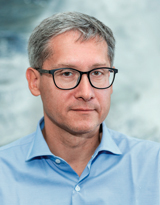Application of the Quasi-enclosed Space Effect in the Formation of Conductive Films on Ceramics by Magnetron Sputtering
https://doi.org/10.17586/0021-3454-2025-68-9-809-816
Abstract
The application of the quasi-closed space effect in the formation of conductive films on ceramics by magnetron sputtering is discussed. This method provides the most flexible possibilities for varying process conditions and thereby influencing the characteristics of the resulting films. One of the process conditions of magnetron sputtering that affects the homogeneity of the composition of the resulting film is the formation of a quasi-closed space in the film deposition zone. A variant of implementing a quasi-closed space is proposed, and a series of copper films are formed using a quasi-closed space and without it. Adhesion and specific surface resistance of the films are determined, and the thickness is determined and the homogeneity of the structures obtained is estimated using scanning electron microscopy. The reduction in the number of defects in conductive films is associated with a higher pressure in the film formation zone in relation to the rest of the vacuum chamber space when implementing a quasi-closed space; the difference in pressure and plasma-forming gas allows, on the one hand, to stabilize the main characteristics of the magnetron discharge, and consequently the film formation process, and on the other hand, to minimize the possibility of including various types of contaminating inclusions in the film structure.
About the Authors
D. E. ShashinRussian Federation
Dmitry E. Shashin — PhD, Associate Professor; Department of Radio Equipment Design and Production
Yoshkar-Ola
A. L. Romanov
Russian Federation
Alexey L. Romanov — Graduate Student; Department of Radio Equipment Design and Production
Yoshkar-Ola
A. D. Dyachkov
Russian Federation
Alexey D. Dyachkov — Post-Graduate Student;Department of Radio Equipment Design and Production
Yoshkar-Ola
E. M. Trachuk
Russian Federation
Eduard M. Trachuk — Graduate Student; Department of Radio Equipment Design and Production
Yoshkar-Ola
A. V. Ivanov
Russian Federation
Anton V. Ivanov —Analytical Laboratory Engineer
Yoshkar-Ola
A. N. Smirnov
Russian Federation
Alexey N. Smirnov — Analytical Laboratory Engineer
Yoshkar-Ola
References
1. Abid N., Shujait S., Chaudhary K. et al. Advances in Colloid and Interface Science, 2022, vol. 300, рр. 102597, DOI 10.1016/j.cis.2021.102597.
2. Pan Yu., Wang J., Lu Zh. et al. International Journal of Hydrogen Energy, 2024, vol. 50, рp. 1179–1193, DOI 10.1016/j. ijhydene.2023.10.143.
3. Barranco A., Borras A., Gonzalez-Elipe A.R., Palmero A. Progress in Materials Science, 2016, vol. 76, рр. 59–153, DOI 10.1016/j.pmatsci.2015.06.003.
4. Deng Y., Chen W., Li B. et al. Ceramics International, 2020, no. 11(46), pp. 18373–18390, DOI 10.1016/j.ceramint.2020.04.168.
5. Calderon Velasco S., Carvalho S., Cavaleiro A. Progress in Materials Science, 2016, vol. 84, рр. 158–191, DOI 10.1016/j.pmatsci.2016.09.005.
6. Stan G.E., Montazerian M., Shearer A. et al. Applied Surface Science, 2024, vol. 646, рр. 158760, DOI 10.1016/j. apsusc.2023.158760.
7. Vahl A., Veziroglu S., Henkel B. et al. Materials, 2019, no. 7(12), pp. 2840, DOI 10.3390/ma12172840.
8. Buchinger J., Koutná N., Mayrhofer P. H. et al. Acta Materialia, 2019, vol. 172, рр. 18–29, DOI 10.1016/j.actamat.2019.04.028.
9. Molaei M.J., Rezakazemi M., Younas M. ACS Applied Electronic Materials, 2021, no. 12(3), pp. 5165–5187, DOI 10.1021/acsaelm.1c00720.
10. Ma Z.Y., Zhang H., Sun X. et al. Applied Surface Science, 2017, vol. 420, рp. 196–204, DOI 10.1016/j.apsusc.2017.05.139.
11. Shashin D.E., Dyachkov A.D. Herald of The Bauman Moscow State Technical University. Series Instrument Engineering, 2024, no. 3(148), pp. 75–90. (in Russ.)
12. Belyanin A.F., Nalimov S.A., Borisov V.V. et al. Vakuumnaya nauka i tekhnika (Vacuum Science and Technology), Proceedings of the XXV Scientific and Technical Conference with the Participation of Foreign Specialists, Moscow, 2018, рр. 170–176. (in Russ.)
13. Shashin D.E. Vestnik of Volga State University of Technology. Series: Radio Engineering and Infocommunication Systems, 2018, no. 4(40), pp. 74–81, DOI 10.15350/2306-2819.2018.4.74. (in Russ.)
14. Shashin D.E., Stepanov S.A., Sushentsov N.I. Vestnik of Volga State University of Technology. Series: Radio Engineering and Infocommunication Systems, 2017, no. 3(35), pp. 69–77. DOI: 10.15350/2306-2819.2017.3.69. (in Russ.)
15. Shashin D.E., Sushentsov N.I., Budkina I.M. Vestnik of Volga State University of Technology. Series: Radio Engineering and Infocommunication Systems, 2021, no. 4(52), pp. 77–85, DOI 10.25686/2306-2819.2021.4.77. (in Russ.)
16. Shashin D.E. Vestnik of Volga State University of Technology. Series: Radio Engineering and Infocommunication Systems, 2019, no. 4(44), pp. 75–84, DOI 10.25686/2306-2819.2019.4.75. (in Russ.)
17. Shashin D.E., Sushentsov N.I. Herald of the Bauman Moscow State Technical University. Series Instrument Engineering, 2019, no. 6(129), рp. 99–109, DOI 10.18698/0236-3933-2019-6-99-109. (in Russ.)
18. Kashin A.S., Ananikov V.P. Russian Chemical Bulletin, 2011, no. 12, pp. 2602–2607.
19. Belyanin А.F., Borisov V.V., Bagdasaryan A.S. Russian Technological Journal, 2017, no. 3(5), pp. 22–40, https://doi.org/10.32362/2500-316X-2017-5-3-22-40. (in Russ.)
Review
For citations:
Shashin D.E., Romanov A.L., Dyachkov A.D., Trachuk E.M., Ivanov A.V., Smirnov A.N. Application of the Quasi-enclosed Space Effect in the Formation of Conductive Films on Ceramics by Magnetron Sputtering. Journal of Instrument Engineering. 2025;68(9):809-816. (In Russ.) https://doi.org/10.17586/0021-3454-2025-68-9-809-816




























